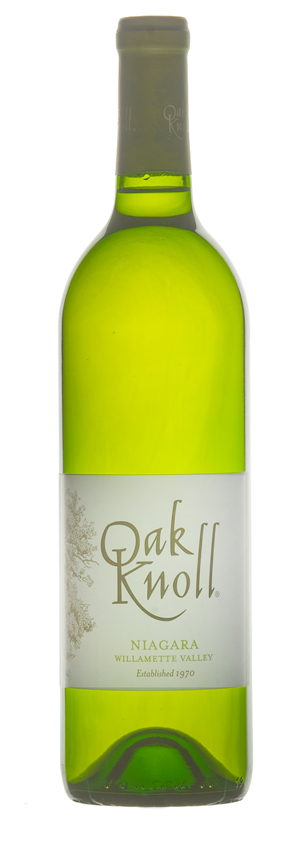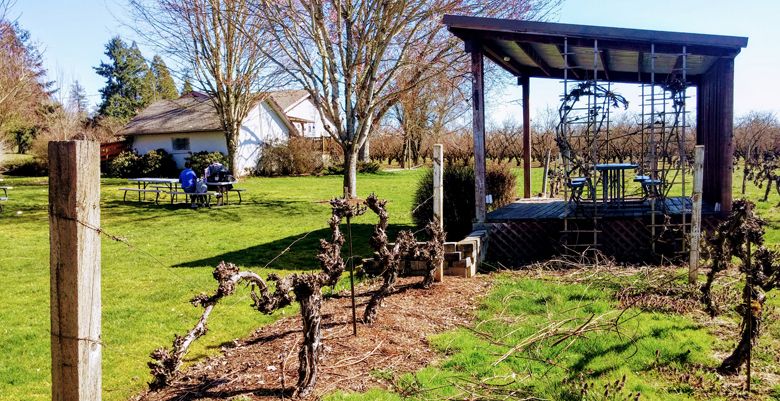Falling for Niagara
Oak Knoll’s take on New York grape a surprising, sweet treat
The Changeup by Michael Alberty
I recently refused to consider a wine because it was made with a grape I’ve always associated with jelly. A friend who knew better suggested I give it a chance. He was right; I was wrong. I’m here to publicly pronounce my love for a semi-sweet wine that costs 10 bucks a bottle: Oak Knoll Winery Estate Niagara.
Claudius Hoag and Benjamin Clark created the variety in 1868 by crossing Concord and Cassady grapes in Niagara County, New York. Niagara belongs to the Vitis labrusca family, the cousins from the wrong side of the vineyard tracks that Vitis vinifera grapes never talk about at the dinner table.

A hundred years after Hoag and Clark created Niagara, Ron and Marjorie Vuylsteke started making fruit wine in Beaverton. Friends and family liked their homemade ferments so much, they urged the couple to go pro. One neighbor even became a silent partner, buying a dairy farm near Hillsboro for the Vuylstekes to convert into a winery.
Oak Knoll Winery received its federal winery license in May 1970, but local authorities were not as accommodating. According to son Steve Vuylsteke, Washington County officials refused to issue a winery permit because there were no grapes planted on the property. Fortunately, the silent partner just happened to be growing Niagara vines on his Copper Mountain property. Cuttings were taken; vines were planted, and Oregon bonded winery No. 50 was ready to roll.
The vines. however, weren’t just planted to appease local bureaucracy. “Niagara vines are cold-hardy and are no muss-no fuss. They just kind of do their own thing, and I liked that,” Marjorie says.
Oak Knoll’s gnarled Niagara produce just enough grape clusters each year to make approximately 100 cases of the estate wine. Oak Knoll also makes a Willamette Valley Niagara for $8.50, which blends a small amount of estate fruit with grapes purchased from other sources.
I recently spoke with the silent partner’s widow, and the 48-year-old vines planted at Oak Knoll are all that remains of her husband’s original plantings. It is also the only vineyard Oak Knoll owns, which I find appropriate. Niagara grapes make a wine Marjorie says “your average Pinot Noir drinker would probably turn their nose up at.” Yet this New York transplant has amassed a cult following who ignore what anyone else thinks. They drink it because they like it.
The volunteer picking crew is also willing to perform manual labor to get first dibs on some bottles. A few years ago, Marjorie put out a call for club members to come pick the estate vineyard’s Niagara grapes. In return, volunteers receive the first chance at buying the highly limited wine. “It turned out so well, I think we will continue the tradition,” Marjorie says. “The volunteers stay with the grapes through picking, sorting and de-stemming process, right up until when the juice goes into stainless steel.”
The enlisted not only have fun earning their Niagara hook-up, they also get their names placed on the bottle. The current 2017 vintage contains 19 names on the back label, from Carole Belcher to Olivia Wright.
I have reasons for initial skittishness: The Vitis labrusca family has a reputation for producing “foxy” wines. The term is a divisive word in wine literature, with some describing it as “musky” and reminiscent of wet fur; the other side describing fresh fruit aromas with phrases like “a goût de cassis” and “fraises des bois.”
And yet, have no fear. There is no fox fur here. The estate Niagara, instead, is a 1970s-style foxy with its Peter Max “Land of Gold” color and spicy floral perfume combining the best of bougainvillea, jasmine and dried rose petals. As far as a fruit aroma, I lean toward wild strawberries dusted with the white powder found on Bazooka Joe bubble gum.
This wine brings a smile to my face — the kind of smile usually reserved for Dave Grusin playing the piano or border collie puppies. It’s a simple sipper that coats the mouth with flavors of peach gelato, Meyer lemon and a cotton candy Jelly Belly.
It hits a solid seven out of 10 on my sweetness scale, which made it a fantastic pairing for my wife’s spicy curried rice and chicken. It also did justice to a dessert course of toasted filberts, sliced pear and a wedge of blue cheese.
I encourage you to seek out this wine at the Oak Knoll tasting room, a beautiful car or bike ride way on a rural road outside Hillsboro. It’s a serene place to sit outside and sip a variety of wines, including one that will pierce your wine dogma by way of a sweet New York grape.
The Changeup, a monthly column by Michael Alberty, is a baseball pitch designed to disorient and confuse. It’s the perfect representation of the unknown and its mastery over those who think they know what to expect. This column is devoted to those unorthodox Oregon wines you never saw coming.











